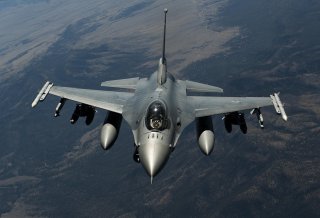Will the F-16 Fighting Falcon Lead Ukraine to Victory Against Russia?
After more than a year of requests, Ukraine is finally about to start receiving General Dynamics F-16 Fighting Falcons.
BUT THESE OLDER F-16S WILL LIKELY NOT OUTCLASS RUSSIA’S MOST ADVANCED FIGHTERS
Providing Ukraine with a respectable number of F-16s will provide the nation with a huge boost in capability, capacity, and even morale. But it’s important to remember that we’re not talking about the latest and greatest top-of-the-line Vipers. Russia will still maintain a significant advantage in terms of numbers, and some of the nation’s most advanced, capable, and well-equipped fighters will still present Ukrainian fighter pilots with real challenges.
There’s a great deal of conjecture about just how well the F-16 can stack up against Russia’s Su-35S (the aircraft’s most common variant). On paper, the twin-engine, thrust-vectoring Russian fighter is the more capable of the two. Despite a much larger wingspan and weight, the Su-35’s thrust vector control gives it a great deal of maneuverability in close quarters and the means to maintain higher degrees of control while flying at a high angle of attack. It comes equipped with Russia’s Irbis-E radar array, which is not as advanced or capable as the more modern Active Electronically Scanned Array radars found in many of America’s front-line fighters, but still outclasses the AN/APG-68 pulse Doppler radar carried by the F-16s Ukraine will get. The Irbis-E is said to have a detection range out to 400 kilometers with modes for air-to-air and air-to-ground operations. The F-16’s AN/APG-68 is said to have a detection range of 296 kilometers, meaning Su-35S will likely be able to spot the F-16 before the F-16 can spot it.
“Our biggest enemy is Russian Su-35 fighter jets,” Juice said. “We know positions of [Russian] air defence, we know their ranges. It’s quite predictable, so we can calculate how long we can stay [inside their zone]. But in the case of fighter jets, they are mobile. They have a good air picture and they know when we’re flying to the front lines.”
But there’s a problem with this on-paper comparison between the Su-35 and F-16… It’s built upon claims made by the Russian government and its primary defense contractors – all of whom have been guilty of exaggerating the capability sets of all sorts of Russian military hardware.
“The Su-35’s specification may indicate it’s a better aircraft by many measures,” former British Royal Air Force Senior Commander and Air Marshal Greg Bagwell told Newsweek, but the true picture “is actually far more complicated than that.”
While the Su-35S does appear to be a rather capable fighter when you asses it in this manner, the pilots who were trained to fly against them offer a different perspective.
Retired U.S. Air Force Lieutenant Colonel Dan Hampton flew 151 combat missions in the F-16 during his tenure in the Air Force, often flying Wild Weasel missions that require an extreme degree of tactical and technical proficiency. His assessment of the Su-35S falls well short of the paper-based conclusions drawn by armchair analysts like myself. Hampton describes the Su-35 as a “typical Russian machine” that “looks good,” but “deep down, it’s not that good of a plane.”
“It looks good at air shows, but my personal opinion is that it’s junk,” Hampton declared in a Ukrainian-language interview he did with Voice of America.
Likely, the truth about the Su-35’s performance lies somewhere in between the claims made by its greatest proponents and detractors, which would make it a formidable foe for Ukrainian F-16 pilots. In truth, Russia will almost certainly send their more capable pilots and fighters after Ukraine’s newfound F-16s in hopes of not only neutralizing their increased combat capabilities but also scoring a significant propaganda victory.
A HELPING HAND TO UKRAINE
After more than a year of Ukraine requesting F-16s and the global media treating these nearly half-century-old jets like they’re the answer to Russian airpower, any F-16 that’s shot down will be met with a chorus of Russian-backed media coverage and troll farms alike calling the fighter, like Ukraine’s hope for victory, a lost cause.
Of course, this all-or-nothing mentality doesn’t actually reflect nuanced reality. It’s almost certain that F-16s will be lost in this war if they manage to see extensive service. However, lost F-16s will neither make the aircraft nor the effort to provide them to Ukraine a failure – that’s just the nature of warfare.
But it’s important to remember that providing F-16s to Ukraine is, perhaps most of all, a significant show of global support for the embattled country and it’s likely that Russian grey zone operations will take great pains to dismiss and diminish to undercut that global support.
So once these jets start flying in Ukraine, it’s vital that we temper our expectations. F-16s are incredibly capable aircraft, but this war is about much more than fighter jets.
And as such, it’ll take much more than fighter jets to win it.
Editor’s Note: This article has been updated to include a clarification on Wild Weasel missions.
Alex Hollings is a writer, dad, and Marine veteran.
This article was first published by Sandboxx News.
Image: Flickr.

